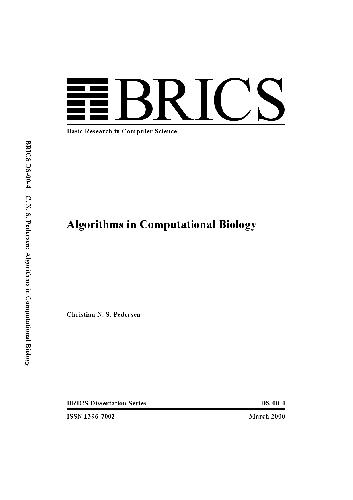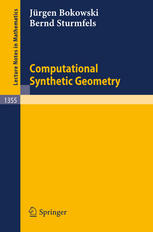William J. Thompson0471547182, 9780471547181
Table of contents :
CONTENTS……Page 7
1.1 What is applicable mathematics?……Page 15
Analysis, numerics, and applications……Page 16
Cooking school, then recipes……Page 17
Roads not taken……Page 18
1.2 Computing, programming, coding……Page 19
The C language for the programs……Page 20
Learning to program in C……Page 21
Translating to Fortran or Pascal from C……Page 22
The computing projects and the programs……Page 23
Caveat emptor about the programs……Page 24
Why and when you should use graphics……Page 25
1.4 Suggestions for using this book……Page 26
The exercises and projects……Page 27
General references……Page 28
References on learning and using C……Page 29
2. A Review of Complex Variables……Page 31
The algebra of complex numbers……Page 32
Programming with complex numbers……Page 34
Complex conjugation, modulus, argument……Page 37
A program for complex conjugate and modulus……Page 39
2.2 The complex plane and plane geometry……Page 41
Cartesian and plane-polar coordinates……Page 42
De Moivre’s theorem and its uses……Page 43
Complex exponentials: Euler’s theorem……Page 45
Applications of Euler’s theorem……Page 46
Hyperbolic functions and their circular analogs……Page 48
Trajectories in the complex plane……Page 52
Phase angles and phasors……Page 55
Vibrations and waves……Page 56
Are complex numbers real?……Page 57
Analytic continuation……Page 58
Stepping into the correct quadrant……Page 59
Coding, testing, and using the program……Page 60
References on complex numbers……Page 63
3.1 Motivation for using series: Taylor’s theorem……Page 65
The geometric series……Page 66
Programming geometric series……Page 67
Alternating series……Page 70
Taylor’s theorem and its proof……Page 72
Interpreting Taylor series……Page 73
3.2 Taylor expansions of useful functions……Page 74
Expansion of exponentials……Page 75
Computing the exponential series……Page 76
Series for circular functions……Page 79
Inverse circular functions……Page 84
Hyperbolic function expansions……Page 85
Logarithms in series expansions……Page 86
Series expansion of x In(x)……Page 87
Deriving the binomial approximation……Page 90
Linearized square-root approximations……Page 92
Financial interest schemes……Page 94
3.4 Diversion: Repetition in mathematics and computing……Page 97
Recursion……Page 98
Coding and checking each series expansion……Page 99
Including the hyperbolic functions……Page 105
The composite program for the functions……Page 106
Using the program to test series convergence……Page 111
References on power series……Page 112
4. Numerical Derivatives and Integrals……Page 113
Properties of the working function……Page 114
A C function for Homer’s algorithm……Page 117
Programming the working function……Page 120
The discreteness of data……Page 124
4.3 Numerical noise in computing……Page 125
Roundoff and truncation errors……Page 126
Unstable problems and unstable methods……Page 128
Errors from subtractive cancellation……Page 130
Program for roots of quadratic equations……Page 133
4.4 How to approximate derivatives……Page 136
Forward-difference derivatives……Page 137
Derivatives by central differences……Page 139
Numerical second derivatives……Page 140
Better algorithms for second derivatives……Page 142
Derivatives of the exponential function……Page 144
Differentiating the cosine function……Page 146
4.6 Numerical integration methods……Page 147
Trapezoid formula and program for integration……Page 149
Simpson formula and program for integrals……Page 154
Integrals with cosines……Page 157
Higher-order polynomial integration……Page 158
4.7 Project 4B: Electrostatic potential from a charged wire……Page 159
Potentials by analytical integration……Page 161
Potentials by numerical-integration methods……Page 162
References on numerical derivatives and integrals……Page 165
5. Fitting Curves through Data……Page 167
What is a spline?……Page 168
Deriving the spline equations……Page 170
The spline algorithm……Page 172
5.2 Boundary conditions for spline fitting……Page 173
Natural splines……Page 174
5.3 Project 5: Program for spline fitting……Page 175
The main program, Cubic Splines……Page 180
The function SplineFit……Page 181
Interpolating values and derivatives……Page 182
The C function Splinelnterp……Page 183
Interpolating working-function values and derivatives……Page 184
Interpolating cosine values and derivatives……Page 187
Deriving the integration algorithm……Page 189
The C function for spline integration……Page 190
Integrating the working function and cosine……Page 191
5.6 Diversion: Computers, splines, and graphics……Page 192
References on spline fitting……Page 193
6. Least-Squares Analysis of Data……Page 195
Maximum likelihood and least squares……Page 196
6.2 Orthogonal functions and linear least squares……Page 199
What are orthogonal functions?……Page 200
Orthogonality and least squares……Page 202
Weighting models……Page 204
Constant ratio of weights……Page 206
Properties of the least-squares slopes……Page 210
6.4 Least-squares normalization factors……Page 213
Normalizing fitting-function values to data……Page 214
Normalizing data to fitting values……Page 215
The best-fit objective function……Page 217
Program for normalizing factors……Page 218
6.5 Logarithmic transformations and parameter biases……Page 222
The origin of bias……Page 223
Probability analysis for bias……Page 224
Dependence of bias on error distribution……Page 226
Organization of Straight-Line Least Squares……Page 228
Testing and using the least-squares program……Page 231
References on least-squares analysis……Page 232
7. Introduction to Differential Equations……Page 235
Why are there differential equations?……Page 236
Notation and classification……Page 237
Homogeneous and linear equations……Page 238
7.2 First-order linear equations: World-record sprints……Page 239
Kinematics of world-record sprints……Page 240
Warming up to the problem……Page 241
Program for analyzing sprint data……Page 243
Women sprinters are getting faster……Page 248
The logistic-growth curve……Page 249
Exploring logistic-growth curves……Page 252
Generalized logistic growth……Page 253
Presenting error values……Page 255
Euler predictor formulas……Page 256
Testing the Euler predictors……Page 258
Adams predictor formulas……Page 259
Programming the differential equation solver……Page 261
Exploring numerical first-order equations……Page 266
References on first-order equations……Page 269
8. Second-Order Differential Equations……Page 271
Forces and second-order equations……Page 272
Mechanical and electrical analogs……Page 273
Solving and interpreting free-motion equations……Page 275
Forced motion and resonances……Page 279
8.2 Catenaries, cathedrals, and nuptial arches……Page 283
The equation of the catenary……Page 284
Catenaries of various shapes and strengths……Page 287
Demonstrating arches……Page 292
8.3 Numerical methods for second-order differential equations……Page 293
Euler-type algorithms for second-order equations……Page 294
Removing first derivatives from second-order linear equations……Page 298
Deriving the Noumerov algorithm for second-order equations……Page 299
Programming the Euler algorithms……Page 301
Euler algorithms and the exponential function……Page 305
Euler algorithms and the cosine function……Page 307
Programming the Noumerov method……Page 308
Testing Noumerov for exponentials and cosines……Page 311
The quantum harmonic oscillator……Page 313
Noumerov solution of the quantum oscillator……Page 315
8.6 Introduction to stiff differential equations……Page 318
What is a stiff differential equation?……Page 319
The Riccati transformation……Page 320
Programming the Riccati algorithm……Page 322
Madelung’s transformation for stiff equations……Page 325
References on second-order equations……Page 326
9. Discrete Fourier Transforms and Fourier Series……Page 329
Types and nomenclature of Fourier expansions……Page 330
Derivation of the discrete transform……Page 332
Properties of the discrete transform……Page 334
Exponential decay and harmonic oscillation……Page 336
Deriving the FFT algorithm……Page 343
Bit reversal to reorder the FFT coefficients……Page 346
Efficiency of FFT and conventional transforms……Page 347
From discrete transforms to series……Page 348
Fourier series for arbitrary intervals……Page 350
9.5 Some practical Fourier series……Page 351
The square-pulse function……Page 352
Program for Fourier series……Page 354
The wedge function……Page 357
The window function……Page 359
The sawtooth function……Page 361
9.6 Diversion: The Wilbraham-Gibbs overshoot……Page 363
Fourier series for the generalized sawtooth……Page 364
The Wilbraham-Gibbs phenomenon……Page 367
Overshoot for the square pulse and sawtooth……Page 370
Numerical methods for summing trigonometric series……Page 373
Building and testing the FFT function……Page 374
Speed testing the FFT algorithm……Page 378
Overview of EEGs and the clinical record……Page 379
Program for the EEG analysis……Page 382
Frequency spectrum analysis of the EEG……Page 386
Filtering the EEG data: The Lanczos filter……Page 387
References on Fourier expansions……Page 389
10.1 From Fourier series to Fourier integrals……Page 391
The transition from series to integrals……Page 392
Dirac delta distributions……Page 393
Exponential decay and harmonic oscillation……Page 394
The square-pulse function……Page 397
Fourier transform of the wedge function……Page 398
Gaussian functions and Fourier transforms……Page 400
Lorentzian functions and their properties……Page 403
Fourier integral transform of a Lorentzian……Page 405
Convolutions: Definition and interpretation……Page 407
Convoluting a boxcar with a Lorentzian……Page 408
Program for convoluting discretized functions……Page 412
Fourier integral transforms and convolutions……Page 415
Convolutions of Gaussians and of Lorentzians……Page 416
Convoluting Gaussians with Lorentzians: Voigt profile……Page 420
10.4 Project 10: Computing and applying the Voigt profile……Page 425
The numerics of Dawson’s integral……Page 426
Program for series expansion of profile……Page 427
Program for direct integration of profile……Page 432
References on Fourier integral transforms……Page 433
EPILOGUE……Page 435
APPENDIX: TRANSLATING BETWEEN C, FORTRAN, AND PASCAL LANGUAGES……Page 437
INDEX TO COMPUTER PROGRAMS……Page 443
INDEX……Page 447







Reviews
There are no reviews yet.